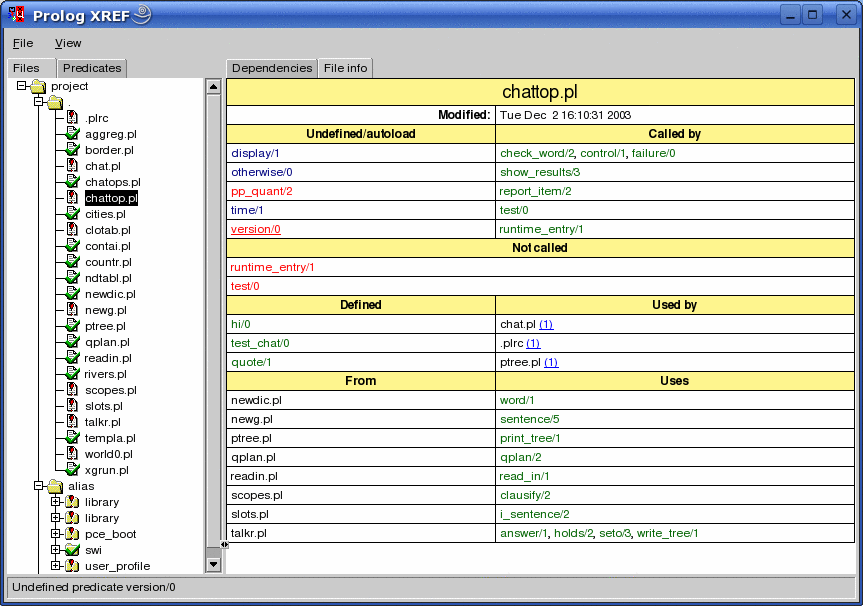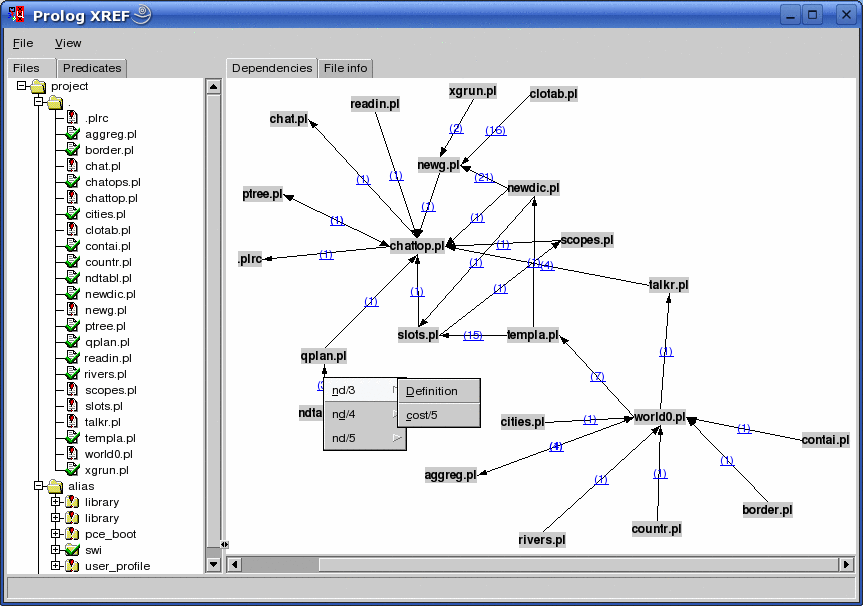




A cross-referencers is a tool examining the caller-callee relation between predicates and using this information to explicate dependency relations between source files, find calls to non-existing predicates and predicates for which no callers can be found. Cross-referencing is useful during program development, reorganisation, cleanup, porting and other program maintenance tasks. The dynamic nature of Prolog makes the task non-trivial. Goals can be created dynamically call/1 after construction of a goal term. Abtract interpretation can find some of such calls, but the ultimately they can come from external communication, making it completely impossible to predict the callee. In other words, the cross-referencer has only partial understanding of the program and its results are necessarily incomplete. Still, it provides valuable information to the developer.
SWI-Prolog's cross-referencer is split into two parts. The standard
Prolog library library(prolog_xref) is an extensible
library for information gathering described in section
A.18 and the XPCE
library library(pce_xref) provides a graphical frontend
for the cross-referencer described here. We demonstrate the tool on
CHAT80, a natural language question and answer system by Fernando C.N.
Pereira and David H.D. Warren.

| Figure 3 : File info for chattop.pl, part of CHAT80 |
The left window (see figure
3 provides browsers for loaded files and predicates. To avoid long
file paths the file hierarchy has three main branches. The first is the
current directory holding the sources. The second is marked alias
and below it are the file-search-path aliases (see file_search_path/2
and
absolute_file_name/3).
Here you find files loaded from the system as well as modules of the
program loaded from other locations using file search path. All loaded
files that fall outside these categories are below the last branch
called /
The File info window shows a file, its main properties, its undefined and not-called predicates and its import- and export relations to other files in the project. Both predicates and files can be opened by clicking on them. The number of callers in a file for a certain predicate is indicated with a blue underlined number. A left-click will open a list and allows to edit the calling predicate.
The Dependencies (see figure 4) window displays a graphical overview of dependencies between files. Using the background menu a complete graph of the project can be created. It is also possible to drag files onto the graph window and use the menu on the nodes to incrementally expand the graph. The underlined blue text indicates the number of predicates used in the destination file. Left-clicking opens a menu to open the definition or select one of the callers.

| Figure 4 : Dependencies between source files of CHAT80 |
Module and non-module files
The cross-referencer threads module and non-module project files differently. Module files have explicit import and export relations and the tool shows the usage and consistency of the relations. Using the menu-command Header the tool creates a consistent import list for the module that can be included in the file. The tool computes the dependency relations between the non-module files. If the user wishes to convert the project into a module-based one the Header command generates an appropriate module header and import list. Note that the cross-referencer may have missed dependencies and does not deal with meta-predicates defined in one module and called in another. Such problems must be resolved manually.
Settings
The following settings can be controlled from the settings menu: